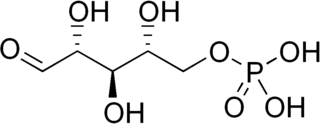
Pantothenic acid (vitamin B5) is a B vitamin and an essential nutrient. All animals need pantothenic acid in order to synthesize coenzyme A (CoA)—essential for metabolizing fatty acid—and to synthesize and metabolize proteins, carbohydrates, and fats.

Threonine is an amino acid that is used in the biosynthesis of proteins. It contains an α-amino group, a carboxyl group, and a side chain containing a hydroxyl group, making it a polar, uncharged amino acid. It is essential in humans, meaning the body cannot synthesize it: it must be obtained from the diet. Threonine is synthesized from aspartate in bacteria such as E. coli. It is encoded by all the codons starting AC.

Coenzyme A (CoA, SHCoA, CoASH) is a coenzyme, notable for its role in the synthesis and oxidation of fatty acids, and the oxidation of pyruvate in the citric acid cycle. All genomes sequenced to date encode enzymes that use coenzyme A as a substrate, and around 4% of cellular enzymes use it (or a thioester) as a substrate. In humans, CoA biosynthesis requires cysteine, pantothenate (vitamin B5), and adenosine triphosphate (ATP).

Acetyl-CoA is a molecule that participates in many biochemical reactions in protein, carbohydrate and lipid metabolism. Its main function is to deliver the acetyl group to the citric acid cycle to be oxidized for energy production. Coenzyme A consists of a β-mercaptoethylamine group linked to the vitamin pantothenic acid (B5) through an amide linkage and 3'-phosphorylated ADP. The acetyl group of acetyl-CoA is linked to the sulfhydryl substituent of the β-mercaptoethylamine group. This thioester linkage is a "high energy" bond, which is particularly reactive. Hydrolysis of the thioester bond is exergonic (−31.5 kJ/mol).

Pyridoxal phosphate (PLP, pyridoxal 5'-phosphate, P5P), the active form of vitamin B6, is a coenzyme in a variety of enzymatic reactions. The International Union of Biochemistry and Molecular Biology has catalogued more than 140 PLP-dependent activities, corresponding to ~4% of all classified activities. The versatility of PLP arises from its ability to covalently bind the substrate, and then to act as an electrophilic catalyst, thereby stabilizing different types of carbanionic reaction intermediates.
In molecular biology, biosynthesis is a multi-step, enzyme-catalyzed process where substrates are converted into more complex products in living organisms. In biosynthesis, simple compounds are modified, converted into other compounds, or joined to form macromolecules. This process often consists of metabolic pathways. Some of these biosynthetic pathways are located within a single cellular organelle, while others involve enzymes that are located within multiple cellular organelles. Examples of these biosynthetic pathways include the production of lipid membrane components and nucleotides. Biosynthesis is usually synonymous with anabolism.
Pantothenate kinase-associated neurodegeneration (PKAN), formerly called Hallervorden–Spatz syndrome, is a genetic degenerative disease of the brain that can lead to parkinsonism, dystonia, dementia, and ultimately death. Neurodegeneration in PKAN is accompanied by an excess of iron that progressively builds up in the brain.
Pantethine (bis-pantethine or co-enzyme pantethine) is a dimeric form of pantetheine, which is produced from pantothenic acid (vitamin B5) by the addition of cysteamine. Pantethine was discovered by Gene Brown, a PhD student at the time. Pantethine is two molecules of pantetheine linked by a disulfide bridge. Pantetheine is an intermediate in the production of coenzyme A by the body. Most vitamin B5 supplements are in the form of calcium pantothenate, a salt of pantothenic acid, with doses in the range of 5 to 10 mg/day. In contrast, pantethine is sold as a dietary supplement for lowering blood cholesterol and triglycerides at doses of 500 to 1200 mg/day.
Pyrimidine biosynthesis occurs both in the body and through organic synthesis.

Ribose 5-phosphate (R5P) is both a product and an intermediate of the pentose phosphate pathway. The last step of the oxidative reactions in the pentose phosphate pathway is the production of ribulose 5-phosphate. Depending on the body's state, ribulose 5-phosphate can reversibly isomerize to ribose 5-phosphate. Ribulose 5-phosphate can alternatively undergo a series of isomerizations as well as transaldolations and transketolations that result in the production of other pentose phosphates as well as fructose 6-phosphate and glyceraldehyde 3-phosphate.
Pantothenate kinase (EC 2.7.1.33, PanK; CoaA) is the first enzyme in the Coenzyme A (CoA) biosynthetic pathway. It phosphorylates pantothenate (vitamin B5) to form 4'-phosphopantothenate at the expense of a molecule of adenosine triphosphate (ATP). It is the rate-limiting step in the biosynthesis of CoA.
The enzyme phosphopantothenoylcysteine decarboxylase (EC 4.1.1.36) catalyzes the chemical reaction
In enzymology, a pantoate—β-alanine ligase is an enzyme that catalyzes the chemical reaction
The enzyme [acyl-carrier-protein] phosphodiesterase (EC 3.1.4.14) catalyzes the reaction
In enzymology, a dephospho-CoA kinase is an enzyme that catalyzes the chemical reaction

In enzymology and molecular biology, a holo-[acyl-carrier-protein] synthase is an enzyme that catalyzes the chemical reaction:

In enzymology, a pantetheine-phosphate adenylyltransferase is an enzyme that catalyzes the chemical reaction

Bifunctional coenzyme A synthase is an enzyme that in mammals is encoded by the COASY gene that catalyses the synthesis of coenzyme A from 4'-phosphopantetheine.

Pantoic acid is the alpha hydroxy acid with the formula HOCH2C(CH3)2CH(OH)CO2H. The compound is almost always encountered in a biological context, as an aqueous solution of its conjugate base pantoate HOCH2C(CH3)2CH(OH)CO2-. The amide of pantoic acid with β-alanine is pantothenic acid (vitamin B5), a component of coenzyme A.

Ketopantoic acid is the organic compound with the formula HOCH2(CH3)2CC(O)CO2H. At physiological conditions, ketopantoic acid exists as its conjugate base, ketopantoate (HOCH2(CH3)2CC(O)CO2−).












